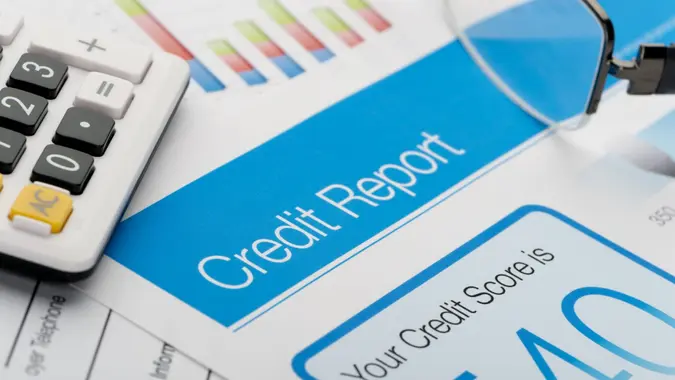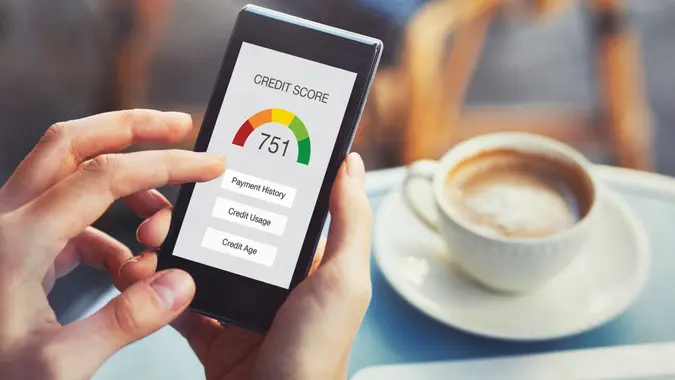What Is a Vantage Score? FICO vs. Vantage Explained for 2025

Commitment to Our Readers
GOBankingRates' editorial team is committed to bringing you unbiased reviews and information. We use data-driven methodologies to evaluate financial products and services - our reviews and ratings are not influenced by advertisers. You can read more about our editorial guidelines and our products and services review methodology.

20 Years
Helping You Live Richer

Reviewed
by Experts

Trusted by
Millions of Readers
A VantageScore is a type of credit score to help lenders decide your creditworthiness. It intends to provide a reliable way of scoring a wider swath of consumers than competing models like FICO, thereby giving more people access to credit.
Like a FICO score, the VantageScore ranges from 300 to 850. Keep in mind, that the VantageScore is used by some lenders, but not all. Most lenders will use your FICO score.
Why Was the VantageScore Created?
VantageScore was created back in 2006 by Equifax, TransUnion and Experian. It was designed to be an alternative to the widely used FICO scoring model. That said, these three credit bureaus still use both systems.
The main purpose behind VantageScore was — and is — to give more consumers access to their credit. It also helps lenders assess consumers’ creditworthiness in a more systematic (and, ideally, fair) way than conventional models. VantageScore doesn’t collect data about people’s income, assets, marital status, race or other personal factors. This makes financing more inclusive and creates more opportunities for people to obtain the financing they need.
As of 2023, approximately 3,400 financial institutions use VantageScore. Tens of millions of consumers also use it to track and understand their personal credit.
The following versions of VantageScore have existed over the years:
- VantageScore 1.0
- VantageScore 2.0
- VantageScore 3.0
- VantageScore 4.0
Each model was built to improve the one that came before. The most commonly used versions today are VantageScore 3.0 and VantageScore 4.0. Both models rely on the same factors (like payment history and credit balances) to score your credit, just in different ways.
Two other models worth noting are:
- VantageScore 4 Plus: This version uses the same tech as 4.0, but it also uses alternative open banking data to give consumers — and lenders — real-time credit scoring data.
- VantageScore 5.0: Model 5.0 is considered “the most advanced and predictive” model. It’s designed for accuracy and is geared toward consumers with limited credit history or who seek unsecured forms of credit.
How Is a VantageScore Different from a FICO Score?
VantageScore and FICO are both scoring models to determine your creditworthiness but are calculated differently and have key differences.
Differences Between VantageScore and FICO Score
| VantageScore | FICO Score | |
|---|---|---|
| Who created it? | All three credit bureaus – Experian, TransUnion, Equifax | Fair Isaac Corporation |
| Who uses it? | Certain lenders for credit applications | Lenders |
| How much of a history do they need to score you? | One month of credit history | At least six months of credit history |
Tri-Bureau vs. Bureau-Specific Models
A tri-bureau scoring model is one that uses data from all three major credit bureaus. That’s VantageScore.
A bureau-specific scoring model uses data from one credit bureau only. That’s FICO. It’s also why you might have three different FICO scores, depending on whether you’re checking your Equifax, Experian or TransUnion score.
Which Model Is Better?
It’s not necessarily a bad thing to use a bureau-specific vs. a tri-bureau scoring model. However, you might find that your FICO score is lower — or higher — at a specific bureau. This is because the data reported, as well as the timing, can vary. Your information might not be updated yet with one credit bureau, or it might be displayed slightly differently.
Your VantageScore might be higher than your FICO score, or vice versa, because of the different scoring models used or the way data is calculated. But both scores are still largely considered accurate.
Know that some banks or lenders will use one score over the other, and that’s OK. It doesn’t mean one system is better or worse than the other. Approximately 90% of U.S. lenders use FICO, but VantageScore has been gaining more traction.
VantageScore 4.0 and VantageScore 3.0
Lenders often use VantageScore 3.0 when making lending decisions about personal loans, credit cards and more. This version also accounts for bankruptcy.
Currently, VantageScore 3.0 is the most commonly used version. But VantageScore 4.0 has become increasingly widespread since its introduction in 2017. It’s designed to make credit scoring more accessible and has reached an estimated 94% of U.S. adults.
The latest version is VantageScore 4.0. It uses predictive modeling, trended data and machine learning to give lenders a clearer overview of a consumer’s credit risk. Rather than provide a snapshot of your credit usage, it looks at your credit over time. It can also help those with limited credit history.
Both models rely on the same factors (like payment history and credit balances) to score your credit. Neither model includes medical collection data in the scoring.
What Are the VantageScore Ranges?
A VantageScore falls in a particular range. The range means different things regarding your creditworthiness. Here are the ranges:
- 300-499 = Very Poor
- 500-600 = Poor
- 601-660 = Fair
- 661-780 = Good
- 781-850 = Excellent
Vantage Score Ranges
What Factors Affect Your VantageScore?
Some factors impact your VantageScore. These factors include the following:
- Payment history (41%): Timely payment of bills matters the most in determining your VantageScore.
- Credit utilization (20%): If you don’t use the full amount of your credit compared to your credit limit, it will weigh more favorably on your VantageScore.
- Credit age and variety of accounts (20%): The number of years you’ve had credit and the kinds of accounts you’ve had (mortgage, credit, loans) will impact your VantageScore.
- New credit inquiries (11%): If you’ve applied for several new accounts, these account inquiries can directly affect your VantageScore.
- Available credit (6%): Unused credit can help your VantageScore.
VantageScore Factors
How to Check Your VantageScore
You can check your VantageScore through any of the three major credit bureaus: Equifax, Experian and TransUnion.
Some banks will left show you your VantageScore if you have an account with them.
Is a VantageScore the Same at All Bureaus?
Your score isn’t always the same. For instance, your Experian VantageScore can be different from your TransUnion VantageScore. This difference is because not every lender reports to all three bureaus.
Your score is dependent on what information the bureaus may have regarding your credit.
Why Your VantageScore Changes
Your VantageScore can change frequently, based on your credit activity, the number of accounts you have open and the types of accounts you have open. How a particular activity impacts your score depends on how high your score was before the activity occurred.
Generally speaking, a negative activity like a late payment hurts a higher score more than it hurts a lower one. That’s because you’re penalized more harshly the first time you have a particular negative activity, and a person with a high score is more likely not to have had a prior negative activity.
Some activities, like getting a car loan or a mortgage loan, can help a low score by indicating a lender’s faith in the borrower. Sometimes, the same activity can hurt a high score, because having multiple active accounts increases your risk of default.
How to Improve Your VantageScore
Your VantageScore is in your hands, and there are proactive measures you can take to improve your score:
Pay on Time
Making timely payments helps with your VantageScore. Timely payments to credit card companies, loans, utility bills and mortgages can influence your VantageScore in a positive way.
Limit Credit Inquiries
Don’t try to open too many accounts at once. An influx of credit inquiries may impact your VantageScore in a negative way.
Keep Accounts Open
Try to keep old accounts open. Having a long history of open accounts can help your VantageScore.
Maintain Low Credit Card Balances
You don’t want to have high credit card balances not only as an impact to your VantageScore, but also for your financial health. Aim to keep your credit card balance less than 30% of your credit limit.
Final Take to GO
Understanding your VantageScore and how it compares to FICO can help you make smarter financial decisions, whether you’re applying for a loan, improving your credit or monitoring your score over time. While both scoring models assess your creditworthiness, they use different criteria and weight factors slightly differently — so knowing which one your lender uses can make a big difference.
If you’re planning a major financial move, like buying a home or refinancing a loan, take the time to check both your FICO and VantageScore. Many credit monitoring services offer free access to one or both, helping you stay informed and proactive.
Next Steps:
- Compare your credit scores — see if your lender uses FICO or VantageScore.
- Check your credit report for errors that might impact your score.
- Take action to improve your credit, whether it’s paying down debt, making on-time payments or keeping credit utilization low.
Angela Mae contributed to the reporting of this article.
FAQs About VantageScores
Figuring out things with your credit score is easier said than done. To help you figure things out, here's some common and frequently asked questions that come up while looking into what is a VantageScore:- What is a VantageScore used for?
- Lenders use the VantageScore to value a borrower's creditworthiness for financial products, loans and credit cards.
- Is a VantageScore the same as a credit score?
- VantageScore is a specific type of credit score and differs from how the FICO score is calculated.
- Why is my VantageScore different from my FICO Score?
- A VantageScore and a Fico score are based on different scoring models. Each may weigh credit factors differently and may pull data from different credit bureaus.
- Do lenders use VantageScores or FICO Scores?
- Most lenders prefer FICO scores, but some use VantageScore for evaluating credit or loan applications.
Editorial Note: This content is not provided by any entity covered in this article. Any opinions, analyses, reviews, ratings or recommendations expressed in this article are those of the author alone and have not been reviewed, approved or otherwise endorsed by any entity named in this article.
Our in-house research team and on-site financial experts work together to create content that’s accurate, impartial, and up to date. We fact-check every single statistic, quote and fact using trusted primary resources to make sure the information we provide is correct. You can learn more about GOBankingRates’ processes and standards in our editorial policy.
 Written by
Written by  Edited by
Edited by 























